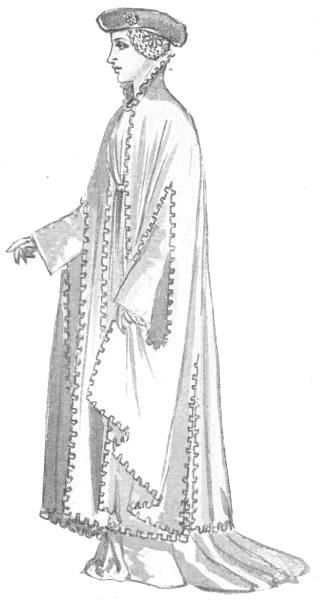Houppelande on:
[Wikipedia]
[Google]
[Amazon]
 A houppelande or houpelande is an outer
A houppelande or houpelande is an outer
File:Prayer_book_of_Maria_d'Harcourt_-_Staatsbibliothek_zu_Berlin_MsGermQuart42_-_f19v.jpg, Woman wearing a houppelande with "dagged" sleeves.
File:Départ_pour_un_pèlerinage_-_Petites_Heures_du_duc_de_Berry_-_BNF_Lat18014_f288v.jpg, The man on the right wears a belted houppelande and a chaperon hat.
File:Les Très Riches Heures du duc de Berry avril.jpg, Houppelande examples from
 A houppelande or houpelande is an outer
A houppelande or houpelande is an outer garment
Clothing (also known as clothes, apparel, and attire) are items worn on the body. Typically, clothing is made of fabrics or textiles, but over time it has included garments made from animal skin and other thin sheets of materials and natural ...
, with a long, full body and flaring sleeves, that was worn by both men and women in Europe
Europe is a large peninsula conventionally considered a continent in its own right because of its great physical size and the weight of its history and traditions. Europe is also considered a subcontinent of Eurasia and it is located entirel ...
in the late Middle Ages
In the history of Europe, the Middle Ages or medieval period lasted approximately from the late 5th to the late 15th centuries, similar to the post-classical period of global history. It began with the fall of the Western Roman Empire ...
. Sometimes the houppelande was lined with fur
Fur is a thick growth of hair that covers the skin of mammals. It consists of a combination of oily guard hair on top and thick underfur beneath. The guard hair keeps moisture from reaching the skin; the underfur acts as an insulating blanket t ...
. The garment was later worn by professional classes, and has remained in Western civilization
Leonardo da Vinci's ''Vitruvian Man''. Based on the correlations of ideal Body proportions">human proportions with geometry described by the ancient Roman architect Vitruvius in Book III of his treatise ''De architectura''.
image:Plato Pio-Cle ...
as the familiar academic
An academy (Attic Greek: Ἀκαδήμεια; Koine Greek Ἀκαδημία) is an institution of secondary or tertiary higher learning (and generally also research or honorary membership). The name traces back to Plato's school of philosophy, ...
and legal robes of today.
The houppelande appeared around 1360 and was to remain fashionable well into the next century. It had its origins in the herigaut, a similar 13th-century garment with hanging sleeves. The edges of the houppelande were often ''dagged'', or cut into decorative patterns such as scallops, "embattled" tabs or even leaf shapes.Ribiero, Aileen, ''Dress and Morality'', Batsford, 1986, reprinted Berg, 2003,
History
The term ''houppelande'' is of French origin; in England it was called a ''goun'', a term of mockery, and in Italy, a ''pellanda''. It is first mentioned in French royal inventories in 1359 and is thought to have originated as a man's housecoat worn over the pourpoint. The woman's and man's houppelande were similar in that both featured flared sleeves, high collars and voluminous skirts. However, there were a few key differences. The man's houppelande was belted at the waist, whereas the woman's was belted beneath the bust. Unlike the woman's houppelande, which was always floor-length, the man's houppelande could be of any length. Some men wore houppelandes that extended only as far as the buttocks, prompting critics to claim that they looked like women from behind. Longer versions were mostly worn on ceremonial occasions. A mid-calf version known as the ''houppelande à mi-jambe'' gained popularity in the 1400s.Gallery
Très Riches Heures du Duc de Berry
The Très Riches Heures du Duc de Berry (; en, The Very Rich Hours of the Duke of Berry) or Très Riches Heures, is the most famous and possibly the best surviving example of manuscript illumination in the late phase of the International Goth ...
, avril
See also
* 1300–1400 in European fashion *1400–1500 in European fashion
Fashion in 15th-century Europe was characterized by a series of extremes and extravagances, from the voluminous robes called houppelandes with their sweeping floor-length sleeves to the revealing doublets and hose of Renaissance Italy. Hats, ho ...
Notes
References
*Ribiero, Aileen, ''Dress and Morality'', Batsford, 1986, reprinted Berg, 2003, *Laver, James: ''The Concise History of Costume and Fashion'', Abrams, 1979. 14th-century fashion 15th-century fashion Medieval European costume Robes and cloaks Gowns History of clothing (Western fashion) {{clothing-stub